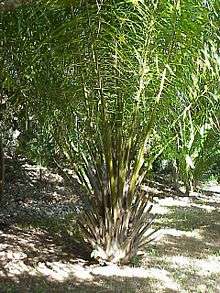Elaeis
| Elaeis | |
|---|---|
 | |
| African Oil Palm (Elaeis guineensis) | |
| Scientific classification | |
| Kingdom: | Plantae |
| Order: | Arecales |
| Family: | Arecaceae |
| Subfamily: | Arecoideae |
| Tribe: | Cocoeae |
| Genus: | Elaeis Jacq. |
| Species | |
| |
| Synonyms[1] | |
Elaeis (from Greek, meaning "oil") is a genus of palms containing two species, called oil palms. They are used in commercial agriculture in the production of palm oil. The African oil palm Elaeis guineensis (the species name guineensis referring to its country of origin) is the principal source of palm oil, it is native to west and southwest Africa, occurring between Angola and Gambia. The American oil palm Elaeis oleifera (from Latin oleifer, meaning "oil-producing")[2] is native to tropical Central and South America,[3] and is used locally for oil production.
Description
Mature palms are single-stemmed, and can grow well over 20 m (66 ft) tall. The leaves are pinnate, and reach between 3–5 m (10–16 ft) long. The flowers are produced in dense clusters; each individual flower is small, with three sepals and three petals.
The palm fruit is reddish, about the size of a large plum, and grows in large bunches. Each fruit is made up of an oily, fleshy outer layer (the pericarp), with a single seed (the palm kernel), also rich in oil.
Species
The two species, E. guineensis and E. oleifera can produce fertile hybrids. The genome of E. guineensis has been sequenced, which has important implications for breeding improved strains of the crop plants.[4]
Commercial palm oil cultivation
Since palm oil contains more saturated fats than oils made from canola, corn, linseed, soybeans, safflower, and sunflowers, it can withstand extreme deep-frying heat and resists oxidation.[5] It contains no trans fat, and its use in food has increased as food-labelling laws have changed to specify trans fat content. Oil from Elaeis guineensis is also used as biofuel.
Human use of oil palms may date back about 5,000 years in coastal west Africa. Palm oil was also discovered in the late 19th century by archaeologists in a tomb at Abydos dating back to 3000 BCE.[6] It is thought that Arab traders brought the oil palm to Egypt.[7]
Elaeis guineensis is now extensively cultivated in tropical countries outside Africa, particularly Malaysia and Indonesia which together produce most of the world supply. Palm oil plantations are under increasing scrutiny for social and environmental harm, particularly because rainforests with high biodiversity are destroyed, greenhouse gas output is increased, and because people are displaced by unscrupulous palm-oil enterprises. Especially in Indonesia, there is also growing pressure for palm oil producers to prove that they are not harming rare animals in the cultivation process.[8]
See also
- Attalea maripa, another oil-producing palm
- Journal of Oil Palm Research
- Energy and the environment
- List of Arecaceae genera
- Social and environmental impact of palm oil
References
| Wikimedia Commons has media related to Elaeis. |
- ↑ "World Checklist of Selected Plant Families".
- ↑ Gledhill, David (2008). The Name of Plants (4 ed.). Cambridge: University Press. p. 279.
- ↑ Collins Guide to Tropical Plants, ISBN 0-00-219112-1
- ↑ Singh, R.; Ong-Abdullah, M.; Low, E.-T.L.; Manaf, M.A.A.; Rosli, R.; Nookiah, R.; Ooi, L.C.-L.; Ooi, S.-E.; Chan, K.-L.; Halim, M.A.; Azizi, N.; Nagappan, J.; Bacher, B.; Lakey, N.; Smith, S.W.; He, D.; Hogan, M.; Budiman, M.A.; Lee, E.K.; DeSalle, R.; Kudrna, D.; Goicoechea, J.L.; Wing, R.A.; Wilson, R.K.; Fulton, R.S.; Ordway, J.M.; Martienssen, R.A.; Sambanthamurthi, R. (2013). "Oil palm genome sequence reveals divergence of interfertile species in Old and New worlds". Nature. advance online publication. doi:10.1038/nature12309.
- ↑ De Marco, Elena; Savarese, Maria; Parisini, Cristina; Battimo, Ilaria; Falco, Salvatore; Sacchi, Raffaele (2007). "Frying performance of a sunflower/palm oil blend in comparison with pure palm oil". European Journal of Lipid Science and Technology. 109 (3): 237. doi:10.1002/ejlt.200600192.
- ↑ Kiple, Kenneth F.; Conee Ornelas, Kriemhild, eds. (2000). The Cambridge World History of Food. Cambridge University Press. ISBN 0521402166. Retrieved 30 August 2012.
- ↑ Obahiagbon, F.I. (2012). "A Review: Aspects of the African Oil Palm (Elaeis guineesis Jacq.)" (PDF). American Journal of Biochemistry and Molecular Biology: 1–14. doi:10.3923/ajbmb.2012. Retrieved 30 August 2012.
- ↑ http://www.npr.org/sections/goatsandsoda/2015/04/21/396815303/palm-oil-plantations-are-blamed-for-many-evils-but-change-is-coming
